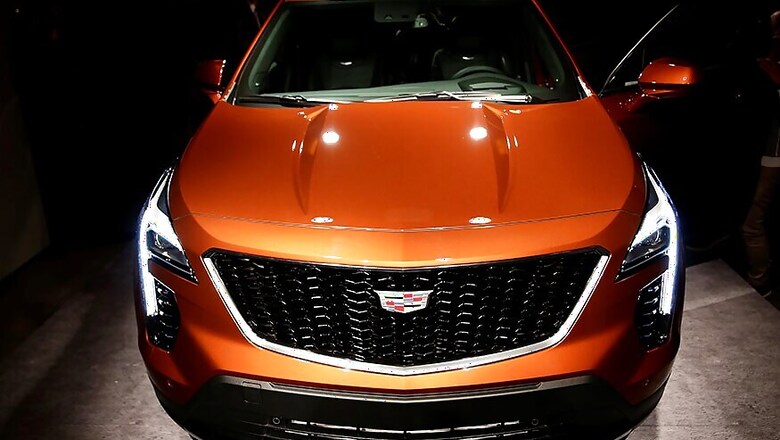
views
Demand for sport utility vehicles in the United States is booming, but the number of new models vying for a share of that market is growing even faster, threatening the fat profits automakers have enjoyed.
At the New York Auto show this week, automakers will unveil another flock of SUVs ranging from a revamped Toyota RAV4, Toyota Motor Corp's top-selling model in 2017, to flashy new luxury Cadillac and Lincoln SUVs. Premium brands such as Fiat Chrysler Automobiles NV's Maserati that once dealt exclusively in low-slung sports cars are getting into the game.
"I think everyone has read the same tea leaves - right now there seems to be insatiable demand," said General Motors Co's Johan de Nysschen, referring to SUVs and crossovers.
De Nysschen, the head of GM's Cadillac luxury division, spoke to Reuters on Wednesday while standing next to the brand's new XT4 crossover model. "Everyone is going into these segments with compelling new entries," he said, "and that means there are going to be winners and there are going to be losers."
He added: "We aim to be amongst the winners."
According to data from automotive consultancy LMC Automotive, by the year 2023 there will be 90 mainstream SUV and crossover models on the U.S. market, as well as 90 luxury models, compared with the 2017 levels of 65 mainstream SUV and crossover models and 53 luxury models.
Premium automakers like BMW AG and Mercedes Benz and Volkswagen AG's Audi brand are expanding their U.S. sport utility vehicle plants.
U.S. sales of mainstream and luxury SUVs and crossovers alike have more than doubled since 2010 and rose 5 percent and 7 percent, respectively, last year - even though overall industry sales declined 2 percent in 2017.
LMC Automotive forecasts that growth will slow for SUVs and crossovers in 2018 and every year through 2025, even as the number of models on the market is set to rise.
For an interactive graphic on "The Rise of the SUV," see: (https://tmsnrt.rs/2I6YBSX)
"There are still some legs left to grow in the SUV market, but growth is slowing and will eventually level off," said Jeff Schuster, LMC's senior vice president of forecasting. "This is a bright spot in the market, which is why everyone is flocking to it with new product."
Over the next few years millions of nearly new SUV and crossover models will come off lease and return to market, providing cheap competition for new models.
Around 40 percent of the roughly 4 million nearly new vehicles that will come off lease in 2018 in the United States will be SUVs and crossovers, rising to 44 percent in 2019 and 47 percent in 2020, according to Cox Automotive forecasts.
"Now that you're seeing more SUVs starting to come off lease, that will automatically put pressure on new SUV pricing," said Karl Brauer, executive publisher for automotive research firm Kelley Blue Book (KBB).
'SIMPLE MATH'
Sam Fiorani, vice president of global vehicle forecasting with AutoForecast Solutions, has a more optimistic view of the automakers' chances. Just as a wide variety of niches has developed in the passenger car market, as SUV and crossover sales continue to grow there is room for automakers to roll out an assortment of sizes, limited editions and sporty models.
"The market is not yet saturated and there are all kinds of niches that have yet to be filled," Fiorani said. "We're five or 10 years from even thinking about market saturation."
Automakers also maintain that there is room for many more options as long as they can stand out in a crowd.
"There are clearly a lot of entrants, but we are going to differentiate ourselves with a completely different look to our brand," Joy Falotico, head of Ford Motor Co's luxury Lincoln division, said in an interview on Tuesday.
Ford's new midsize SUV with three rows of seats, the Aviator, will hit the U.S. market in 2019. Rather than the aggressive or dominant forms adopted by Lincoln's competitors, Falotico said the Aviator's form is meant to evoke "beauty and calmness."
But according to KBB's Brauer, "Simple math suggests that you'll have more models with lower volume."
"You can't have that many SUVs on the market and have all of them grow volume," he said. "Some of them are going to have to give."
Brauer points to average vehicle prices in the SUV and crossover market for an indication of what is happening in the segment. Cumulatively, prices rose just 4 percent from 2012 to 2017.
But the average price dipped 0.5 percent to $35,991 in 2017 from $36,163 in 2016, according to KBB data.
Faced with more competition in a slower-growing market, automakers will likely be forced to resort to consumer discounts to boost sales, which will cut in to profit margins.
"The idea that you're going to make the same profit as you did three years ago is probably unlikely," Brauer said. "The good news is that they have room to lower margins."
Also Watch:




















Comments
0 comment